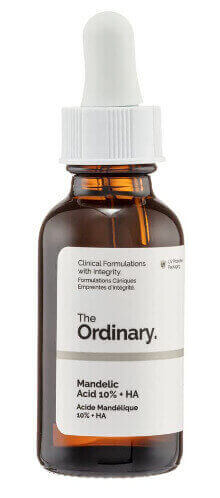The three main types of alpha hydroxy acids (AHAs) are glycolic acid, lactic acid and mandelic acid. Among these three, mandelic acid is the most suitable and least harmful for darker skin tones. This is primarily due to its larger molecular size that is gentler on the skin.
Mandelic Acid for Hyperpigmentation

Mandelic acid is especially popular in treating hyperpigmentation issues in people of color. It will help lighten dark spots over time by exfoliating the skin without causing any inflammatory reaction.
An especially popular product on Amazon is The Ordinary mandelic acid 10% + HA with alpha hydroxy acid (AHA) and hydrating hyaluronic acid. This topical has an average rating of 4.5 out of 5 stars based on almost 2,000 reviews as of the time of writing this post.
An even higher strength product is Naturium Mandelic Acid 12% plus Niacinamide. You can also purchase creams and gels containing this key ingredient.
A 2013 study from the US found that a combination treatment with vitamin C and mandelic acid resulted in successful short-term and long-term treatment of melasma and post-inflammatory hyperpigmentation.
Mandelic acid does not kill melanocyte cells, so it will not exacerbate your existing hyperpigmentation and skin discoloration. According to New York based dermatologist Dr. Sejal Shah, as told to Allure:
Despite its larger particle size, mandelic acid also delves deeper into skin than other AHAs because it is oil-soluble. Glycolic and lactic acids, on the other hand, are water-soluble, so they only work on the top layers of skin.
The Skin Benefits of Mandelic Acid
Mandelic acid can improve your skin texture, clear your pores, accelerate cell turnover, exfoliate, brighten dull skin, and reduce areas of discoloration and excess pigmentation. The end results is even toned, clearer, smoother, brighter and plumper skin. Note that it is recommended to use SPF sunscreen when using this acid, since it can make your skin more sensitive to sunlight and UV ray exposure.
Other Alternatives
For people with sensitive skin, glycolic acids and lactic acids can sometimes cause side effects. In that case, mandelic acid is a great alternative. However, even the last mentioned can cause some skin redness and irritation. Make sure to also read my past posts on tranexamic cream for skin lightening and cysteamine cream for treating hyperpigmentation. If you are only interested in mild exfoliation and skin brightening, kojic acid is a good naturally-derived ingredient that is suitable for skin of color.
How often Should you use Mandelic Acid?
In the beginning, it is recommended to use a mandelic acid based product just one to two times per week. Thereafter, if your skin can handle it without any adverse reactions, you can increase the frequency of application to three to four times per week.